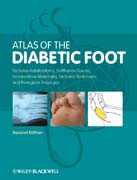
Atlas of the diabetic foot
Katsilambros, Nicholas
Dounis, Eleftherios
Makrilakis, Konstantinos
Foot ulcers occur in approximately 15% of the patients with diabetes mellitusin their lifetime, with a major impact on their quality of life. Many hospital admissions related to diabetes are due to foot ulcers, which can result in prolonged hospital stay and increased morbidity and mortality. The majority of lower limb amputations are performed in patients with diabetes every year (80,000 at least in the USA). Most of the diabetes-related foot problems can be prevented or their severity reduced by early detection and treatment. This book contributes to improved foot care through raised awareness of prevention, clinical manifestations, diagnosis and management among healthcare professionals. This comprehensive atlas, now in a second edition, provides: 520 colour photographs, graphs, tables and imaging studies. Educational examples taken from genuine case reports. A reference guide for identifying patients at risk for footproblems. Illustration of common problems such as neuropathic and neuroischaemic ulcers, ischaemia and infection. Introduction to new technologies and bioengineered materials used for the treatment of foot ulcers. This book will be of interest to diabetologists, endocrinologists, podiatrists, specialist nurses, general practitioners, surgeons and clinical researchers. Nicholas Katsilambros MD, Professor in Internal Medicine Athens UniversityMedical School Eygenideio Hospital and Research Laboratory ?Christeas Hall? Athens, Greece. Eleftherios Dounis MD, FACS, Director Orthopedia Department Laiko General Hospital Athens, Greece. Konstantinos Makrilakis MD, MPH, PhD, Assistant Professor in Internal Medicine Athens University Medical School 1st Department of Propaedeutic Medicine Laiko General Hospital Athens, Greece. Nicholas Tentolouris MD, Asssistant Professor 1st Department of Propaedeutic MedicineAthens University Medical School Laiko General Hospital Athens, Greece. Panagiotis Tsapogas MD, Medical and Diabetes Department Medical Bioprognosis Corfu,Greece. INDICE: INTRODUCTION. Epidemiology. Economy aspects. Aetiopathogenesis of foot problems in diabetes - text & 2 graphs. Classification of foot problems -text & table & graphs. I. DIABETIC NEUROPATHY. Methods of assessment of the foot at risk. Physical examination. Monofilaments. Tactile sensation (Light touch - cotton wool). Vibration perception (tuning fork) Biothesiometer. Pain sensation. Proprioception. Temperature percption. Reflexes. Pedobarograph. II. ANATOMY RISK FACTORS FOR THE DIABETIC FOOT - FOOT DEFORMITIES. Muscle weakness. Prominence of metatarsal heads. Claw toes. Hammer toes. Hallux valgus. Halux varus. Hallux rigidus. Hallux pronation. Bunionette. Splaying of the front foot. Curly toes. Mallet. Toe overriding. Pes cavus. Pes planus. Previous (minor) amputation. III. OTHER FOOT RISK FACTORS. Callus. Haemorhagic callus. Oedema. Corns. Nail deformities. Bullae diabeticorum. Inappropriate footware. IV. OTHER RISK FACTORS. Postural instability. Poor vision. Social factors. V. NEUROPATHIC ULCERS. Over a callus in various sites of the foot. Over a bone prominenceor in various foot deformities. On a toe (tips, dorsum of phalanges). Over a metatarsal head. Heat injuries. (figures, pedobarograph images, radiology studies etc as applied in each case). VI. PERIPHERAL VASCULAR DISEASE. Clinical history. Physical examination. Non-invasive tests. Arteriography. VII. ISCHAEMICULCERS. At various sites. Toes and inner aspects of toes. Foot dorsum. Sole. Outer and inner aspect of the foot. Dry gangrene. Wet gangrene. VIII. CHARCOT FOOT. Ulcer on a Charcot foot. IX. THE NEUROISCHAEMIC ULCER. X. INFECTIONS. Nail infections. Fungal infections of toes and foot. Cellulites. Deep tissue infections. Osteomyelitis. (radiology studies, CT scans, MRI, scintigraphy etc). XI. METHODS OF PREVENTION. Patient education. Appropriate footware, socks. XII. METHODS OF ULCER HEALING. OFFLOADING. Bed resting, wheelchair, crutches, total cast, scotch cast boot, shoes, insoles. DRESSINGS. OTHER METHODS. Hyperbaric oxygen.
- ISBN: 978-1-4051-9179-1
- Editorial: Wiley-Blackwell
- Encuadernacion: Cartoné
- Páginas: 252
- Fecha Publicación: 21/01/2010
- Nº Volúmenes: 1
- Idioma: Inglés
